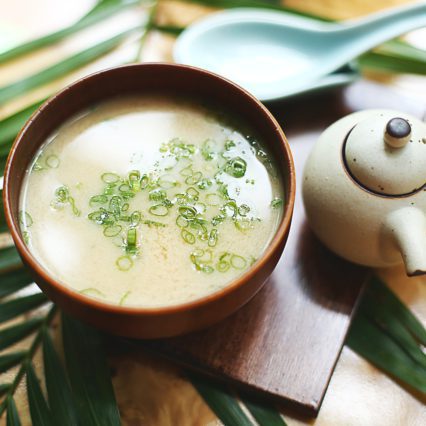Guide to Japanese Appetizers

Guide to Japanese Appetizers
Agedashi Tofu
Deep-fried in a light batter, topped with dashi flakes and scallions, and served in tentsuyu broth, agedashi tofu warms your soul. The tofu itself is crispy without being heavy, while the dashi, scallions, and broth provide that savory flavor. Deep-frying can sometimes be intimidating, but agedashi tofu takes neither a lot of time nor many steps.
Karaage
This is a method of deep-frying often associated with chicken, although it can be applied to many foods. Unlike tempura which uses batter, karaage just involves coating a marinated food in flour or starch and frying. Needless to say, it’s the bee’s knees.
Edamame
Soybeans in the shell, prepared via steaming or boiling. Sometimes served with salt, edamame is sneakily satisfying and probably the easiest thing to make on this whole list.
Yakitori
Chicken on a skewer that’s basted and grilled over charcoal flame. The flame-grilling creates delicious char over parts of the chicken, while the sauce applied during or shortly after cooking gives it further tangy, slightly sweet taste. Yakitori doesn’t involve any complicated preparations, yet has a delightful end result.
Gyoza
Japanese dumplings filled with various vegetables and meats. They can be pan-fried, boiled or steamed, or deep-fried — you can’t go wrong no matter how you cook them. Here’s a look at making your own homemade pan-fried gyoza. Did you know we make our own seasoned pork for gyoza daily our meat department?
Chawan Mushi
A savory Japanese custard with a mix of vegetables and sometimes meat. The dashi, mirin, and soy sauce in the custard help contribute to the umami flavor while the additional ingredients provide other flavors and a complementary, hardier texture to go with the silky smoothness. For a more in-depth look at chawanmushi, we wrote about it here.
Kaki Fry
Japanese fried oysters! They’re covered in panko bread crumbs and then deep-fried to a perfect golden color. Ideal for when it’s a bit chilly outside, kaki fry is uncomplicated yet satisfying.
Tempura
Karaage’s airier cousin, tempura is seafood or vegetables dipped in light batter and fried. Popular ingredients to use include shrimp, fish, squash, carrot, green bean, onion, and pumpkin, but these are far from all of the foods that can be tempura-ified. And along with being super tasty, tempura’s easy to make at home, too!
Croquette
Many cultures have some version of a croquette, and Japan is no different. Also called “korokke,” Japanese croquettes can have many different fillings — usually mixed with mashed potatoes — before being smashed into a thick patty, covered in breadcrumbs, and fried. Croquette is satisfying, warming, and delicious.
Takoyaki
Grilled octopus balls! Think meatballs, but instead of beef, made with minced octopus, green onion, and tenkasu. This mixture is rolled up and coated with batter before being pan fried in half-spherical griddle molds specifically used for takoyaki. Learn more about this funky little sphere of goodness here.
Saba Shio
A simple way of preparing mackerel. If you look at the name — and speak Japanese — it’s self-explanatory: “saba” is mackerel, while “shio” is salt. This salted mackerel is then grilled directly on flame and ends up crispy on the outside and tender within. If you prefer to cook saba shio an oven, you can also broil saba shio.
Miso Soup
A light, dashi- and miso-based soup… so, pretty much exactly what the name suggests. You’ve probably encountered it as an appetizer at Japanese restaurants, although miso soup actually can be quite diverse with varying types of miso, dashi, and soup contents. Miso soup’s so lovely, we dedicated a whole page to it!
These appetizers are all wholesome and tasty whether you’re enjoying them in their own right or while waiting for the main meal. By trying some out in the kitchen, you’ll have a whole new arsenal of delicious, homemade, and (mostly) healthy snacks at your disposal!




